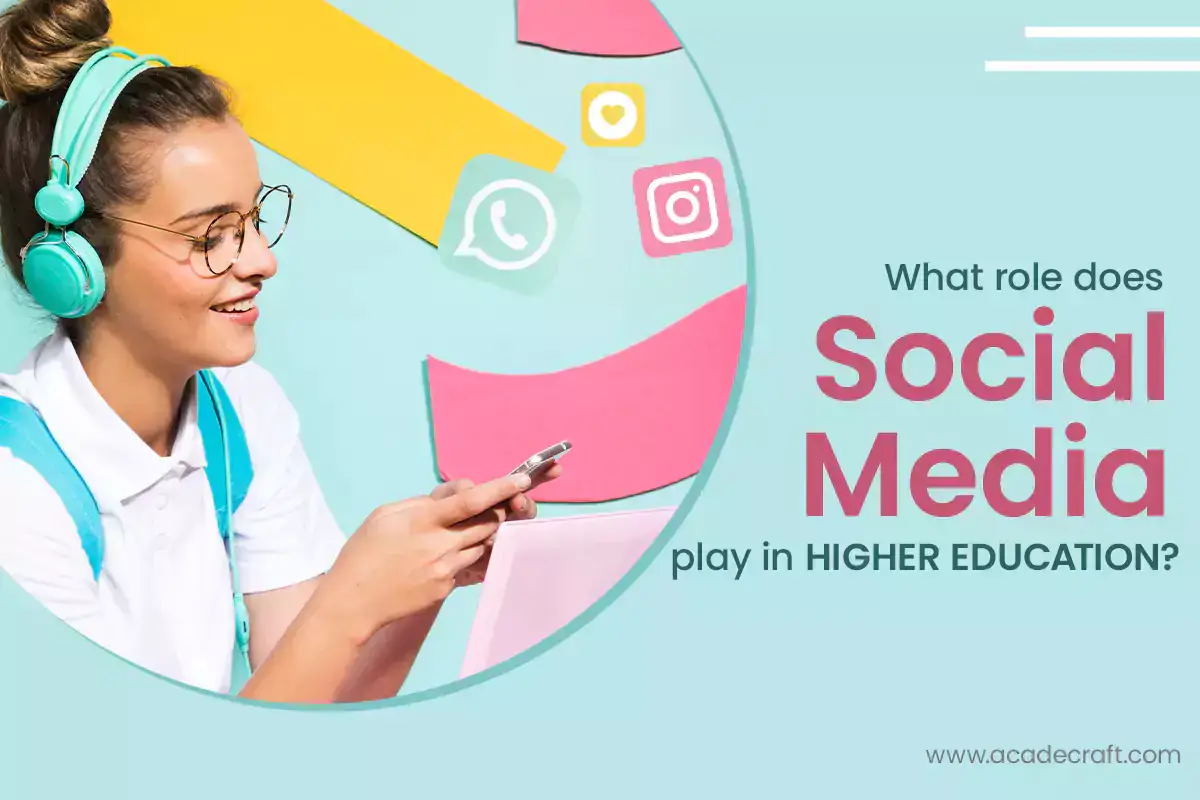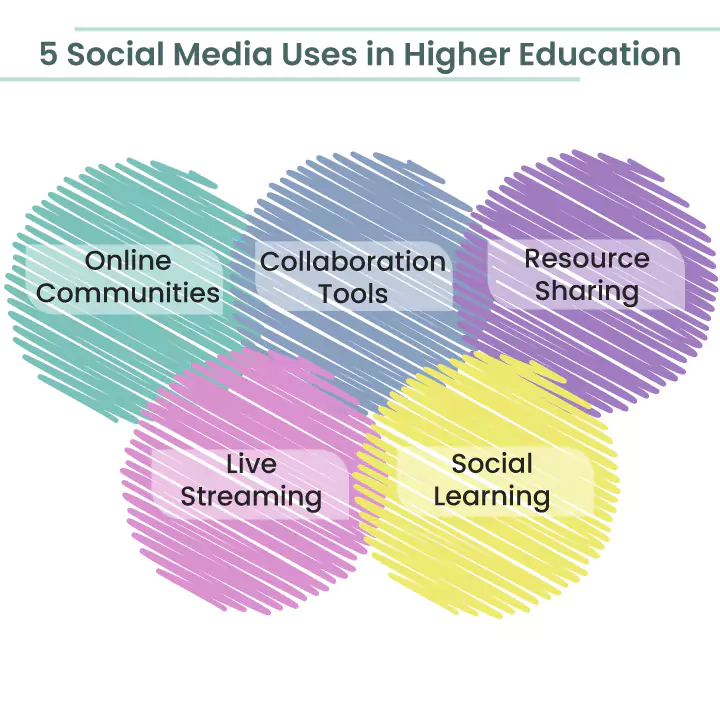
Social media have become integral to modern life, and higher education is no exception. The role of social media in higher education has changed how universities and colleges interact with their faculty, students, and alumni. Social media has provided new opportunities for educational institutions to market their programs, reach out to potential students, and construct relationships with alumni. It has also allowed students to connect with their peers, share resources, and collaborate on projects.
Social media is now the standard for higher education institutions in this digital era. Be it from the connections to recruitment to fundraising to risk management; it is a potent communications tool for post-secondary institutions of every stripe. Due to this, we'll dig into expanding the role and various uses of social media in higher education in this blog. Learn to use social tools in building your educational institution's reputation while fostering a sense of collegiate community.
There has been a lot of discussion regarding how social media affects a student's academic performance. Some people believe it has a negative and disturbing effect on students. If it is used improperly, this statement may be precise. However, if it is used wisely, it can be a great asset for students. Let us understand social media's role and various uses in higher education.
Social media has altered the landscape of higher education in numerous ways. It has allowed students, teachers, and the academic community to interact, collaborate, and communicate in new and exciting ways. A few of the major functions of social media in higher education include the following:
Social media platforms effectively involve students in classroom discussions and learning activities. They provide a more relaxed and engaging learning environment, which can foster a sense of community and increase student engagement. For example, teachers can use social media to post assignments, share resources, and provide student feedback.
Social media platforms have greatly facilitated teacher-student communication and collaboration. They provide tools like file sharing, video conferencing, and instant messaging that can help speed up communication and boost teamwork.
Students can connect with industry leaders, employers, and other experts in their field using social media sites like Twitter and LinkedIn.
One can share educational videos with students worldwide by uploading them to YouTube, Facebook, and Instagram. Learning faculty can connect with college students via social media platforms such as Facebook, Google Plus groups, and YouTube. These platforms can distribute bulletins, speak about campus news, and give college students useful information.
As a result of the increased engagement between university and college students, many of the problems that students face can be solved through group interactions.
The resources and tools available on social media platforms can be customized to meet each student's needs. Teachers can use social media to design custom content development plans, offer personalized feedback, and provide additional assistance to students who require it.
For example, a teacher could set up a private Facebook group for their students to discuss course material and ask questions or post helpful content to their Twitter page. By creating these online spaces, the teacher can provide students with a safe, secure, and reliable environment to discuss course material and seek help.
Social networking platforms can be effective resources for professional growth in higher education. They provide a variety of chances for educators and students to interact with subject matter specialists, participate in online communities, and impart their knowledge and skills to others.
Online learning platforms offer a variety of features, such as interactive lectures, video lectures, quizzes, forum discussions, and other collaborative activities, which allow educators and students to engage with subject matter experts and share their knowledge and skills with other users.
For instance, interactive lectures allow the educator to present materials and activities, monitor student performance in real-time, and receive student feedback, creating an engaging learning experience.
Also Read: Top Trends of Higher Education 2023
Now that we've looked at the role of social media in higher education, let's look at some of the specific uses of social media in this context.

Students and teachers can connect and work with others in their field through various online communities that social media platforms like Facebook and LinkedIn offer. These online communities offer a space for idea exchange, scholarly discussion, and professional networking.
Various collaboration tools on social media platforms like Google Drive, Dropbox, and Evernote can be used to improve productivity and teamwork in higher education. These tools allow teachers and students to collaborate on projects, share files, and give each other real-time feedback.
Sharing educational resources and materials can be done effectively using social media platforms. Teachers and students can use social media to share videos, articles, and other resources and exchange notes and other study materials.
There are many opportunities for teachers to deliver live lectures and tutorials to their students through live streaming platforms like YouTube and Facebook Live. It can be especially helpful for students who live in remote areas or cannot travel to class in person.
Various social and educational opportunities are available on social media platforms, which may increase student motivation and engagement. Teachers can use social media to set up online tests, games, and other interactive activities to encourage student participation and teamwork.
The use of social media in daily life has made it much easier and faster for teachers and students to interact regarding studies. We live in a world where online interactions have become essential, and students are already experts at online presence. They are mindful of operating simple and complicated functions on several social media sites.
The blend of ed-tech "education with technology" learning has given an exciting opportunity in the modern digital era. Educators and students can use social media to enhance their courses, study patterns, and grow in their respective fields.
Social platforms are universal or versatile; anyone from teachers and students to parents and professionals can use them according to their convenience.
Here are some points that will explain the importance of social media in higher education:
College students are exposed to the internet through mobile phones, tablets, and other devices. In this manner, they can easily inform friends and family of the information.
Many people can benefit from the knowledge, advice, projects, and study materials individuals can share. Communication allows students to share information about exams and classes.
This feature is phenomenal since it has simplified the exchange of information without their being mindful of the abilities being developed daily. It also gives students more growth opportunities.
Today, everyone is familiar with the word "marketing." Pursuing social media marketing is a growing career option for students. It assists students in preparing to be successful marketers.
As every business must incorporate social media marketing into their groups, students worldwide can use social media strategies for various companies. It is impossible if a person has no prior knowledge of social media.
For instance, a student might work with a company to develop a social media strategy that includes creating content, scheduling posts, and engaging with users on various platforms. They could also measure the campaign's success by tracking engagement rates, website clicks, and other key performance indicators. The student could then use their findings to make recommendations for further improvement.
Social media allows students to get enrollment in top universities for higher education. The majority of high school students are known to prefer using social media when looking for colleges and enrolling in them.
Facebook is among one of the most popular social sites today. Students have grown accustomed to a specific social network and expect detailed information to be provided quickly.
To improve their academic abilities, those currently pursuing higher education or about to do so must use social media.
Higher education institutions must specify the importance of standing out from the crowd. Innovative social media strategies that must be used year-round are required for higher education.
Social Media has become an essential tool for higher education. It engages students, improves collaboration, fosters communication, and fosters research and learning. As social media continues to evolve, it will undoubtedly be an important part of the higher education experience.
| Benefits of Social Media for Teachers, Students, and Educational Institutions |
| Teachers | Students | Institutions |
| Improved Communication and Engagement with Students | Increased Engagement and Motivation | Increased Visibility and Brand Awareness |
| Enhanced Professional Development Opportunities | Enhanced Collaborative Learning | Improved Student Recruitment and Retention |
| Increased Access to Educational Resources | Improved Access to Educational Resources | Enhanced Collaboration and Knowledge Sharing |
The role of social media in higher education has expanded engagement, communication, and collaboration opportunities. It has also become an essential part of academic life.
Although there are some drawbacks to social media use in this situation, there are also many advantages that can help improve communication and collaboration, increase student engagement, and offer teachers and students valuable opportunities for professional growth.
Teachers can give their students more effective and interesting learning experiences while preparing them for success in a world that is changing quickly by utilizing social media.
Share